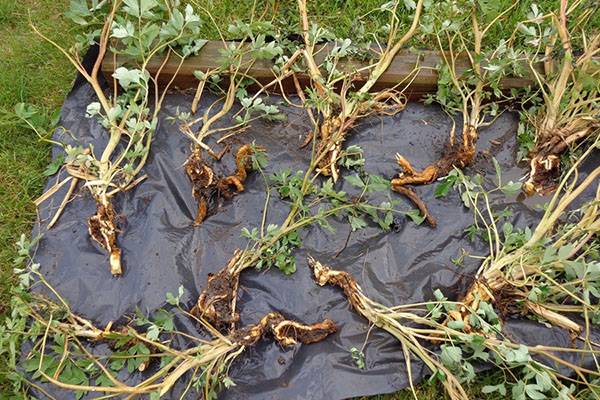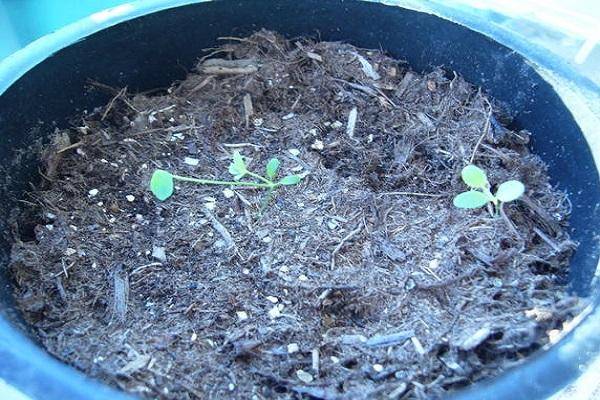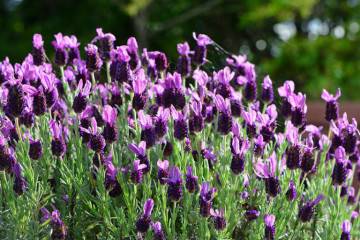Dicenter flower - planting and care in the open field
Content:
The flower of the dicentra (Dicentra spectabilis) belongs to herbaceous perennials, belongs to the Poppy family. The plant gained fame because of its unusual flowers in the shape of hearts. An unpretentious culture gets along well with different species, does not require special knowledge for cultivation.
Dicenter characteristics: varieties and varieties
Botanists distinguish several types of flowers. Each of them deserves special attention and can easily decorate the area around the house.
The center is magnificent
Also known as the superior or dicentra Broken Heart. The homeland of the plant is considered to be North America, its western regions. Known to gardeners since 1812, there is a white-flowered and pink-flowered form of an exceptional dicentra.
A perennial plant grows up to 20 cm, has leafless fleshy shoots. Leaf plates emerge from basal rosettes, flowers up to 25 mm in diameter, are collected in arcuate inflorescences up to 15 cm long. It blooms from the third decade of May, decorates household plots for up to 3 months in a row.
The center is beautiful
Came to European countries from British Columbia. The maximum height of the bush is 30 cm, the foliage on the seamy side is painted in a light gray shade. The leaves are located on long petioles, are part of the basal rosettes. Inflorescences 10-15 cm long, consist of pinkish-purple flowers, up to 20 mm in diameter.
The culture blooms by the end of May, new buds appear until autumn. Plants need winter shelter, despite their frost resistance.
The variety includes the following varieties:
- Dicentra White Aurora (white) - differs in a non-standard color of buds, the lower petals are of a snow-white shade, the upper ones are pearlescent.
- King of Hearts - with rose-colored flowers and light blue leaf plates with a bluish bloom.
- Oregana - with deep pink or whitish-creamy buds covered with pinkish rime.
Dicenter nodular
Naturally occurs in Washington and Oregon (North America). On the roots there are small nodules, foliage with a greenish-gray tint, collected in rosettes. Peduncles grow up to 30 cm, they have white flowers with long spurs.
A subspecies is Pittsburgh with graceful pinkish buds, there is another variety - with lemon-yellowish petals.
Dicenter golden-flowered (gold)
It grows in distant Mexico and on the Californian slopes (at an altitude of about 1.7 thousand m). Shrubs grow from 45 cm to 1.5 m.
Flowering begins in the second half of April and lasts until early September. The flowers have a yellowish color and two irregularly curved petals. The variety is known for its whimsicality when living in personal plots, in natural conditions it prefers to grow at the site of a fire.
Dicenter one-flowered
It grows in the northern territories of America, Utah and Idaho.The culture has single buds from February to July, the height of the peduncle does not exceed 10 cm. The leaf plates are pinnate, the general appearance of the culture is very spectacular.
Looking after this dicenter is difficult and requires certain skills.
Dicenter golden vine
It differs from other subspecies in sunny flowers. Liana-like plant forms shoots up to 3 m, blooms from June to autumn.
Planting a plant
Experienced gardeners recommend planting work from 15 April to the end of May. In this case, it is necessary to take into account the weather conditions of the region. Plants are not planted until the ground warms up to 10 degrees and the threat of frost return disappears. Some growers prefer to plant young growth before the autumn cold - on September days.
Seed planting
Seed material is rarely used due to the rapid loss of germination. Sowing is carried out in pre-prepared boxes, which, after the procedures, are sent to a cool room, with a temperature regime of 18-20 degrees. The first shoots appear in one calendar month.
After the formation of two true leaves, a dive is carried out:
- in open ground;
- in a greenhouse with weak heating.
Planting seedlings
Dicenter spectabilis are planted in accordance with the generally accepted scheme:
- Dig holes with a width of 40 cm and a depth of 30 cm.
- An interval of 35 cm is observed between the pits.
- The bottom is laid out with drainage material - broken brick or crushed stone, at a level of 10 cm.
- A mixture of sand and wood ash, taken in equal proportions, is poured at the bottom of the hole.
- The plant is placed exactly in the center, the root system is straightened. The root collar should be flush with the ground.
- The voids are covered with nutritious soil.
The landing site is carefully compacted, the earth is abundantly moistened. Be sure to carry out mulching, with a layer thickness of 5 to 8 cm.
Watering and loosening the soil
The culture requires systematic and moderate soil moisture. In the summer months, watering is carried out up to 2 times a week; in case of drought, it is necessary to do additional spraying of foliage and soil with a spray bottle with cool water.
After the buds have dried, the frequency of soil moistening is reduced several times, the procedures are resumed only during the spring growing season.
For the plant, the dicenter is constantly maintained looseness of the soil. The landing site is constantly loosened, improving aeration. The procedure is combined with the next watering - twice a month. At the same time, they are engaged in the removal of weeds from the site.
Reproduction methods
Growers prefer to use two main options to propagate the plant.
Shrub division
Bushes older than 3 years are subjected to the procedure. The bush is carefully dug up and set aside near the hole, in the open air. After half an hour, the root system loses its fragility, it can be easily divided into parts without fear of damage. Each part should have at least 2-4 buds, this size will allow the young to grow and develop normally.
It is allowed to cut the rhizome into small fragments, from 8 to 10 cm. After drying and treatment with a disinfectant, the bushes are seated in the shade. At the end of the procedure, they are watered abundantly.
Cuttings
Cuttings are cut from the first weeks of spring. Young shoots with a height of 15 cm are considered suitable. The cut site is immersed in a root stimulator for 24 hours, then the plants are sent to pots filled with light and nutritious soil.
Each container is covered with glass containers - they are removed only after the first leaves are formed. The appearance of foliage indicates the formation of a root system and the beginning of the development of a new individual.
Top dressing and fertilizers
The care of the dicenter includes the enrichment of the soil with nutrients. At the beginning of the spring season, the soil is fertilized with superphosphates, and after the formation of the first buds - with nitrogen-containing fertilizers. Due to the latter, the flowering time is extended. In the autumn, it is fertilized with humus, the root system is watered with manure infusion.
Plant transplant
When is it better to transplant the dicenter: during the first 5-6 years, the culture does not need to be moved to a new place. Operations are carried out in spring or autumn. The shrub is carefully dug up and divided into several independent parts - the condition is associated with the peculiarities of the culture, partial death or decay of the roots.
The cut site is treated with activated carbon powder or ash, the roots are dried for 3 hours. After that, a transfer to a previously prepared place is carried out.
Pruning the dicenter
The plant is characterized by rapid growth and the formation of a significant number of shoots. In the absence of plant control, it can reach several meters. To preserve a beautiful appearance, sanitary and decorative pruning is carried out. During the growing season, too long, weakened and deformed shoots and foliage are excised.
Pests and diseases
Valentine's dicenter has a small number of enemies - it is resistant to attacks of parasites and diseases:
- With neglect of plantings and excessive watering, rotting of the root system can be observed.
- On young foliage, stripes, rings or spots of a paler color than the main color of the foliage sometimes appear. The problem is associated with tobacco mosaic or ring spot.
- In rare cases, when the buds bloom, the petals remain yellow-light green or green, the peduncle begins to bend, stops in growth and development. Symptoms occur when mycoplasma disease is affected.
The only serious plant parasite is aphids. Its appearance is not sporadic: constantly moving insects swarm throughout the green part of the plant. Pests are destroyed with insecticidal preparations, spraying not only the affected individual, but also nearby plants.
Why a foreign guest can turn yellow: at the end of the season, after the buds fall, he prepares for winter rest. The second reason for the non-standard appearance of the bush includes a lack of water or nutrients, poor oxygen supply to the root system.
Flowering period and care during this period
The buds bloom in early June and decorate the garden throughout the summer. The time for the formation of new flowers is prolonged by pruning dried inflorescences.
Preparing for winter
Shrubs that remain outside for the winter must be prepared for the winter season. After carrying out sanitary pruning (up to a third of the plant), the ground is mulched with a ten-centimeter layer of peat, covered with spruce paws or special agrofibre on top.
Experienced gardeners advise in cold regions to dig out the culture, followed by transplantation in containers. The boxes are sent to a closed room, where the temperature regime is 3-6 degrees. Landing back is carried out after warming and setting a stable heat, without the risk of return frosts.
Use in landscape design
White and other decenters are used to decorate personal plots. Tall hybrid varieties are suitable for mixed flower beds, they are ideal for taking root near trees or shrubs with a dense crown. Dwarf subspecies (up to 50 cm in height) are suitable for alpine slides and rock gardens, look good on curbs and around garden paths.
The plant can be grown in flowerpots, placing them in any corner of the garden. This method is suitable for decorating festive events.
Suitable neighbors for a dicenter include:
- tulip;
- early iris;
- primrose;
- corydalis;
- fern;
- host;
- lungwort;
- heuchera;
- badan;
- Brunner.
The design of the garden depends on the imagination of the designer. If desired, you can use different types of dicenter: from miniature to giant sizes, combining them in small groups. The most important thing in design is not to overdo it with the number of colors and not give the backyard a ridiculous look.
The flower is classified as an ornamental crop. The planting and maintenance of the center, which most often does not require special knowledge or conditions of detention, is a real decoration of the garden. Prolonged flowering and the absence of difficulties in supervision allows beginners in gardening to deal with the plant.





















